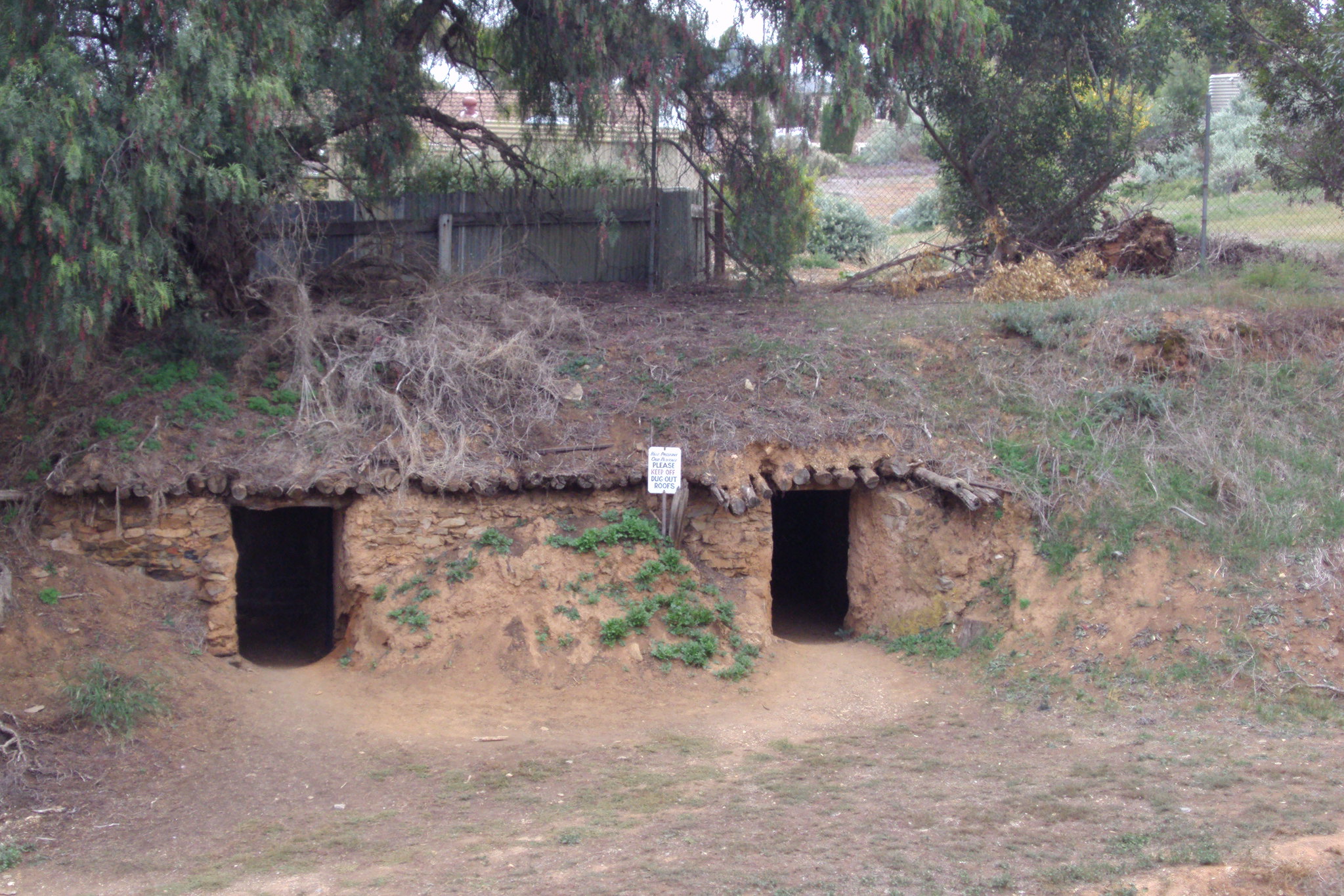Set amidst grassy hills, the lonely settlement of Burra is located 160 kilometres north of Adelaide, South Australia.
The discovery of copper near the Burra Burra Creek in 1845, led
to the establishment of this historic town, with its wonderful stone buildings and Cornish miners' cottages.
Ngadjuri Aboriginal People
The history of this town begins with the Ngadjuri (Nga-dju-ri) Aboriginal people, a nomadic group who used petroglyphs and body art to express their
cultural beliefs. Burial sites and rock art can be found to the northeast of Burra, at a place known as Kooringa to the Aboriginal people.
Before Europeans arrived, Aboriginal people would have spent their nights around camps fires. There were no towns or cities or street lights. Life would have been very different from what we experience today. There was also no written languages, and so, stories of the Dreamtime were passed orally.
Imagine the Aboriginal people, during those long hours of the night, looking upward at the starry skies and
seeing the five stars of the South Cross (Wildu), sparking in the great dome of darkness above them. To the Ngadjuri, this star arrangement was believed to
be the footprint of the Wedge-tailed eagle.
The Ngadjuri also believed that the Sun went to the Underworld after killing of an old woman and her two dingo dogs (Tindale 1937). Most Australian Aboriginal tribes regarded the sun as female and the moon as male. The Sun, Moon, several planets, and many of the stars, are linked by Dreamtime stories with
ancestral beings, who once were on the earth, but now live in the stars.
As with most Aboriginal groups, the Ngadjuri men would hunt animals for food, while the women gathered roots and other plants, cared for the children and maintained the campsite.
An initiated Ngadjuri elder, Barney Waria, born in 1873, worked with anthropologists, Norman Tindale, Ronald Berndt and Charles Mountford (The notes of Ronald Berndt are under embargo). Barney provided information about the Ngadjuri, as having kinship through the female line (Matrilineality) and how he learned about sorcery from his mother's father.
 |
| Corroboree of Aboriginals, South Australia, circa 1889, State Library of South Australia |
 |
| The Elder Scientific Exploration Expedition, 1891-2: Aboriginal Australians and their humpy, also known as a gunyah, or wurlie, is a small, temporary shelter, traditionally used by Australian Aboriginal people. This one is from South Australia, SLSA |
The Europeans
The crew of a Dutch vessel, the
Gulden Zeepaert, led by Captain François Thijssen, were the first Europeans to explore South Australia.
After this, Matthew Flinders led the circumnavigation of Australia aboard
HMS Investigator, in 1801-2. Strangely enough, French Captain Nicolas Baudin, was also surveying the southern coast of the Australian continent in 1802.
In 1829, the National Colonization Society formed in Britain, based on the ideas of Edward Gibbon Wakefield's "concept of ‘systematic colonisation". These ideas were implemented a few years later. Land in South Australia would be sold at a higher price that would pay for the immigration of free settlers, who at first, would be unable
to afford land, and so, would become the labouring class. There would be no need for convicts. Economic growth would result, and by concentrating settlement, a civilized society capable of self-government would evolve. Ironically, Gibbon himself was in prison when he devised the scheme.
In 1830, Charles Sturt's expedition from New South Wales reached the mouth of the Murray River.
The Nobs and The Snobs
The first European squatter in the Burra area, which was originally called The Burra, was William Peter, born in Perthshire, Scotland in 1818.
In 1845, two shepherds, William Streair and Thomas Pickett, separately found copper ores on the banks of Burra Burra Creek. Two rival groups then made application to buy the land on which the ore was found. The first group, called "the nobs", were
wealthy capitalists, including the owner of the Kapunda
Copper mine and they were interested in the southern half. While the group of merchants and shopkeepers interested in the northern half were called "the snobs". The Snobs struck it rich, but the Nobs' mines soon petered out and the land was sold off as a sheep station, becoming the Princess Royal Station.
 |
| Princess Royal homestead near Burra. The occupants at the time were Andrew and Gwen Tennant. Approximately 1950, SLSA |
The Burra Burra Mine
The Snobs' Burra Burra mine, from 1845 to 1877, produced approximately 50,000 tonnes of copper, which helped Australia to become the largest copper producer in the world.
They Came From Cornwall, Wales, Scotland and Germany
The Burra Burra Mine, which was known as the "Monster Mine", made a fortune from copper finds, but the "copper kings" paid very little in wages to the miners doing the work.
Many of these miners of Burra, had been brought to Australia from the mines of Cornwall, by the South Australian Mining Association, which also
established a town and homes for the miners. However, for various reasons,
many of the miners preferred to live in dugouts on the banks of Burra Creek. These dugouts housed 400-500 people, along several miles of creek.
 |
| Cornish miners working in the mines at Burra. Approximately 1870, SLSA |
 |
| The picture shows a dug-out constructed by the miners in the early days of Burra. South Australia. Sydney Mail (NSW : 1912 - 1938), Wednesday 5 May 1926 |
Kooringa Wesleyan Chapel built as the first church in 1847.
 |
| Miner's strikes, South Australian (Adelaide, SA : 1844 - 1851), Tuesday 17 October 1848 |
Paxton Square Cottages (others below)
The South Australian Mining Association had cottages built at Paxton Square to encourage the miners to leave their dugouts next to the creek. The first 14 cottages were constructed in 1849 and all 33 completed by 1851.
Paxton Square was named after William Paxton, one of the
investors in the Burra copper mines. He returned to England in July 1855, a wealthy man.
 |
| Paxton Square Cottages, Burra, built 1849-1851 SA, circa 1937 |
Floods
In 1859, floods forced the Cornish miners to leave their dugout homes. They then established their own village and named it after the Cornish town of Redruth. Other miners, including the Welsh miners, also established their own villages, like Aberdeen and Llwychr, which today are part of Burra.
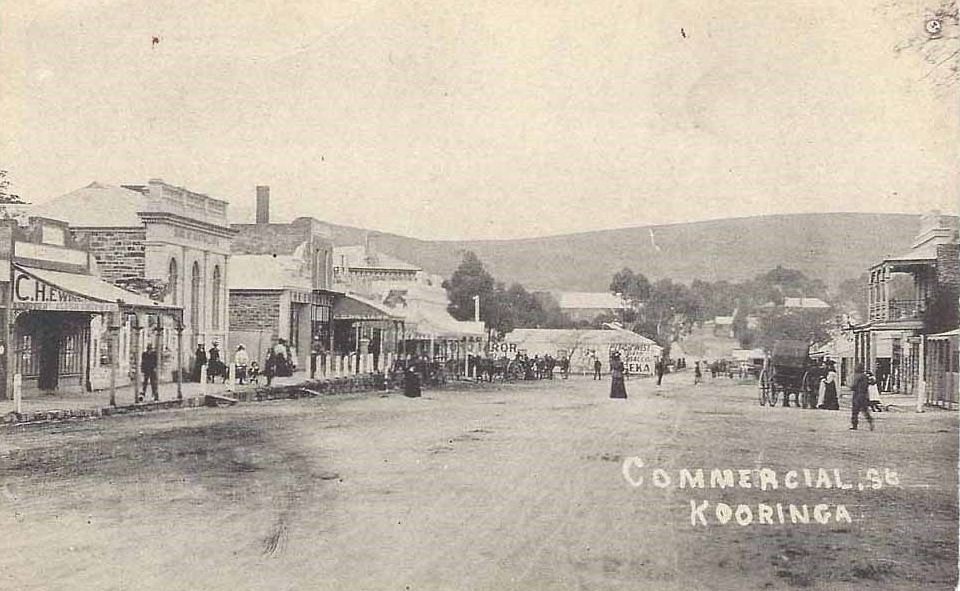 |
| The town of Burra began in 1846 as the company town of Kooringa Aussie~mobs |
Prosperity
The population of Burra peeked in 1851 with 5000 inhabitants. It was a prosperous town at this time, with many facilities, including a hospital, a gaol, churches and a brickworks.
 |
| Panoramic view of the Burra Copper Mine. Morphett's engine house and winding house can be seen in the centre. On the left is the ore crushing house. Concentrating sheds are seen in the foreground. [On back of photograph] 'Burra Copper Mines / Probably in the eighteen seventies'. SLSA |
The Miners’ Arms Hotel was first licensed in 1847, the town’s second hotel. The hotel was damaged by fire in December 1878. In the following year,
a new hotel was built, incorporating some of the surviving structure and the name was changed to the Burra Hotel.
 |
| Horse-drawn Cab owned by T. Hall, outside the Burra Hotel, c1917, SLSA |
Fossil Finds
Diprotodon or megafauna bones were first found near Worlds End near Burra in 1890. The mega Thylacinus from this site became extinct about 45,000 years ago, while the Diprotodon became extinct about 25,000 years ago. The Diprotodon from this site dates to 40,000 years ago.
 |
| Diprotodon or megafauna bones found near Baldina Station, SA, now a recognized archaeological site |
1870s
The idea to build a railway to Burra was proposed as early as 1850. In 1870 the first train arrived at Burra, along with a rabbit plague.
In 1873 the Original Unicorn
Brewery was established at Burra, by William Banks. The Brewery closed in 1902 and the buildings demolished for their stone in 1911.
 |
| Unicorn Brewery, Paxton Terrace, Burra (In Brewery yard). This brewery was established by William Banks in 1873. Approximately 1890. SLSA |
The Burra Record newspaper began as the Northern Mail which was first published on 30 June 1876.
 |
| The Burra Record was a newspaper covering Burra and the mid-north eastern area of South Australia that was first printed in June 1876. |
 |
| Panoramic view of the Burra Copper Mines showing non-operating horse whims in the foreground. [On back of photograph] 'Burra Copper Mine 1876 |
 |
| Copper mine Burra. Circa 1870 |
The Burra Hotel became the town's first public hospital in 1878.
 |
| Burra Hospital, previously the Burra Hotel. Kapunda Herald (SA : 1878 - 1951), Friday 22 December 1905 |
 |
| The Bon Accord Hotel was built in 1874, and originally provided stabling for horse and trap. Large paddocks at the rear of the hotel were for horses to graze. Kapunda Herald (SA : 1878 - 1951), Friday 9 October 1908 |
1880s
 |
| The offices of Packard, Solicitor, together with Goodchild, Duff and Co., Auctioneers, with the staff and passerbys standing out the front. According to the Burra History Group, this photograph was taken in Market Square, Kooringa, Burra c.1881. SLSA |
A New Century
 |
| Open cut Burra Burra Mine, Kapunda Herald (SA : 1878 - 1951), Friday 4 May 1906 |
Wayward Girls
Redruth Girls' Reformatory was established by the government in 1897 in the former Redruth Gaol outside Burra.
 |
| Redruth Girls' Reformatory was established by the government in 1897. Protestant girls were sent to Redruth and Catholic girls to the Catholic Girls' Reformatory, Kapunda. Chronicle (Adelaide, SA : 1895 - 1954), Saturday 19 February 1921 |
 |
| Matron of the Redruth Girls' Reformatory, Register (Adelaide, SA : 1901 - 1929), Friday 11 February 1921 |
Market Square
 |
|
Bird's-eye view of Aberdeen and Redruth, SA, Kapunda Herald (SA : 1878 - 1951), Friday 5 August 1904 |
 |
| Market Square, Burra , SA, Aproximately 1903, SLSA |
 |
| Burra Market Square, SA, Kapunda Herald (SA : 1878 - 1951), Friday 2 September 1904 |
 |
| Hockey at Burra. Males players in fancy dress with ladies, Chronicle (Adelaide, SA : 1895 - 1954), Saturday 19 August 1911 |
 |
| Burra Constable Thomas joins a group outside of the shop of J. Harris & Sons. Circa 1909 |
 |
| Miss Alice Pearce (representing the Sunday School) of Burra laying a corner foundation stone for the new Kooringa Methodist Church in March 1914 |
The Burra Cheer-Up Ladies Band
The Burra Cheer-Up Ladies Band was created in 1915 when a number of the town's young local women had the idea to learn at least two songs so that they could welcome home returned soldiers. Many of the women had never played an instrument before and most couldn't read music. One member said:
"We will not dwell on the musical nature of that first evening, only to add that the girls were never more determined to do their best. We held two or three practices and tried our best to blow some musical sounds through the instruments, but the majority of the instruments refused to do what was required of them, and we had to retire beaten."
The band leader was Trix Pearce, who was a fundraiser for the returned soldiers, a cellist, pianist and organist, A-grade tennis player and a crack shot with a rifle.
See here
 |
| Observer (Adelaide, SA : 1905 - 1931), Saturday 14 August 1915 |
 |
| Burra Market Street, Burra. Circa 1915 |
At War
A Burra Boy's Letter.
No. 4 Command Depot, Wareham: Jan. 31st. 1917.
A letter from Pte. George Hill to his Mother
"— Just a few lines to let you know I am still alive and doing well. Hope you are all the same. I am down at Wareham again and I don't think it will be long before I am back in France with the boys. Well Mother, I have had a splendid, time since I recovered from my wounds. Have been to Scotland and find it is the best place I have been in since I left home, there are a lot of places to see in Edinburgh, that would be of interest to anyone, especially the "'Scott Monument" which I visited. It is 200ft 6 inches high, 180ft top gallery, 287 steps, which takes getting to the top and then I had a good view of the city. The Architect, George M. Kemp. "A Shepherd's Son", foundation stone was laid in 1840, and opened Oct. 1884. Cost £15,650. A lot of other places I visited but can't explain it on paper, will tell you all about them when I come. I had a great surprise yesterday, who should I meet but Twist Ockenden so had a good talk him. will see him again as he isn't camped far from where I am, he told me Jack Steadman was here, so will try and find him if possible. Am living in hopes of seeing the other boys some day, I hope they are all well. Kindly remember me to all over there and tell the Cheer-Up Society I will write to them one day. Wishing them every success with their work."
Burra Record (SA : 1878 - 1954), Wednesday 25 April 1917, page 3
Saving Private Ockenden: The Story of Six Brothers Who Served in WWI
 |
| Laying foundation stone of the soldiers' memorial, Brurra, SA. Observer (Adelaide, SA : 1905 - 1931), Saturday 16 April 1921 |
 |
| Fallen Soldiers' memorial, Burma, SA, Chronicle (Adelaide, SA : 1895 - 1954), Saturday 4 March 1922 |
Joy Ride
During
the Great Depression, in 1932, Sir Charles Kingsford Smith landed at Burra in his plane,
Southern Cross and local people who could afford to pay were taken for a ride.
 |
| Newcastle Sun (NSW : 1918 - 1954), Wednesday 15 May 1935 |
 |
| Commercial street west side, Burra, SA, circa 1933. Business's to be seen include McKenzie and Company Grocers, Frank Spencer Jeweller, JW Sullivan Tobacconist, Hairdresser, The Record Print Office and the Bank of Australasia. There are several cars and a lorry parked on the street. Circa 1933 |
WWII Declared
 |
| Burra Record (SA : 1878 - 1954), Tuesday 5 September 1939 |
In 1980, some parts of the filming of Breaker Morant, took place in Burma.
Historic Cottages
McBride Cottages
Robert James Martin McBride arrived in Adelaide in 1855, with only five shillings. He became a wealthy pastoralist and philanthropist and built this row of attached cottages for elderly citizens in 1910.
 |
| Chronicle (Adelaide, SA : 1895 - 1954), Saturday 10 December 1910 |
Tiver's Row
James Tiver arrived in South Australia in 1854 and was employed as a mason at the Burra Smelting Works. He built the first of these cottages in 1856 and erected many buildings including the Railway Station and Redruth Methodist Church.
 |
| Tiver's Row, Burra, 1856. Tiver a mason arrived S.A. 1854, erected many buildings including Railway Station and Redruth Methodist Church |
9-13 Truro Street, Burra
Miners cottages built in the 1850s, 9-13 Truro Street, Burra.
 |
| Early Cornish- style miners' cottages, Burra, SA |
Around Burra
William Paxton (1818 – 1893) 33 was one of the investors in the Burra copper mines. He owned these cottages, in three terraces around Paxton Square, which were built by Cornish masons for the South Australian Mining Association, to encourage the mining families to leave their dugouts along Burra Creek
 |
| 19th Century cottages in Burra, South Australia |
 |
| Burra Town Hall, SA Circa 1879, The Town Hall, as it is now known, has also been used as a picture and stage theatre |
 |
| The Kooringa Hotel in Kooringa, a former suburb of Burra, SA |
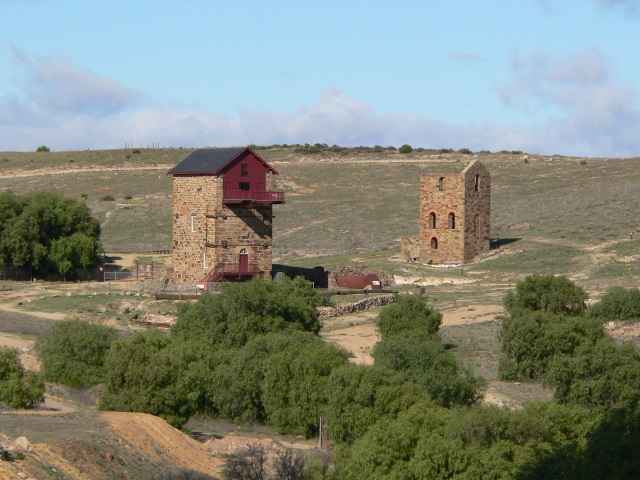 |
| Old mine buildings at the Burra copper mine, SA |
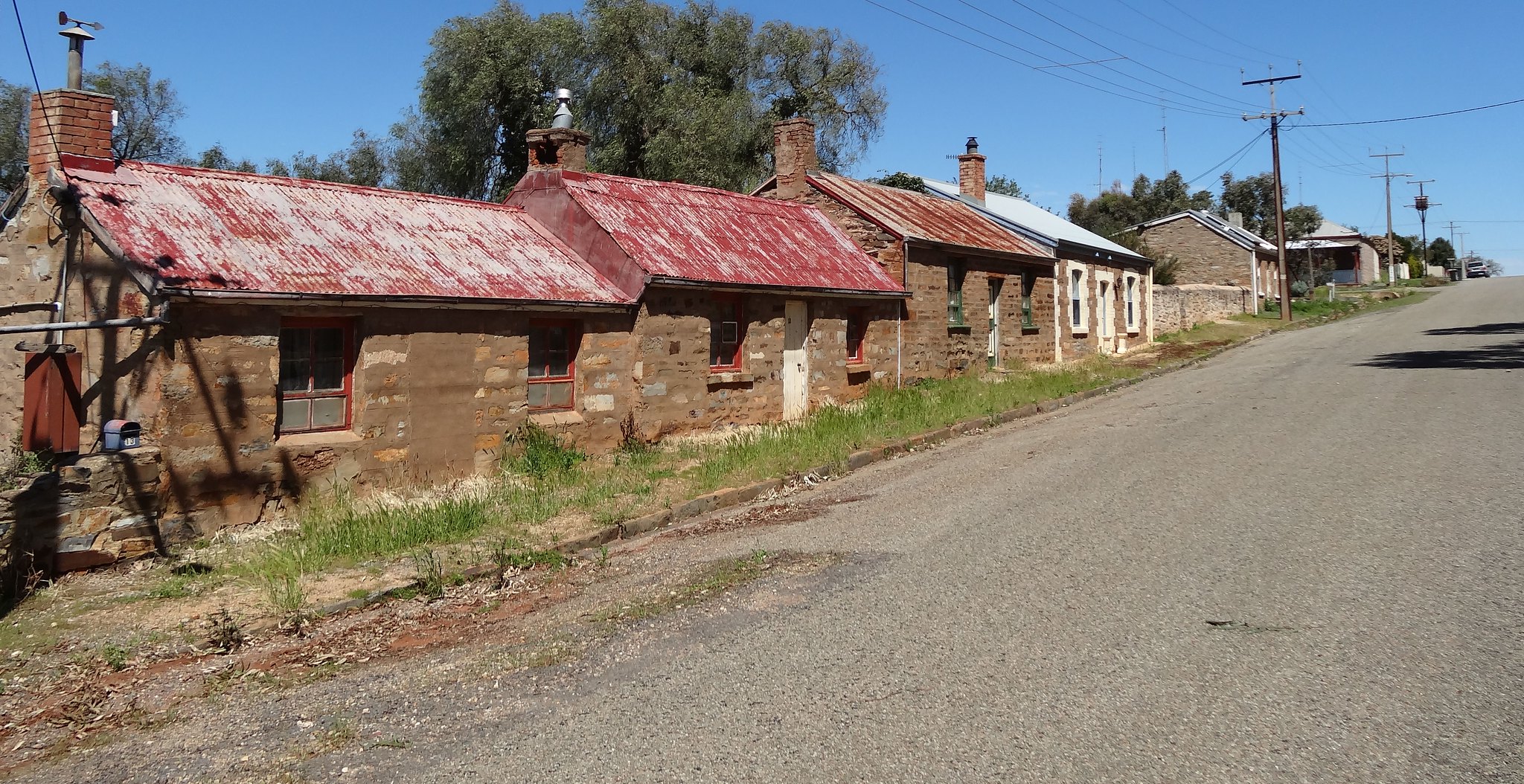 |
| Burra. Copper mining town from 1845. Old miners cottages in Truro Street Redruth. denisbin |
 |
| Farmhouse, now in ruins. South of Burra, SA |
 |
| Morphetts winding house, at the Burra copper mine, SA |
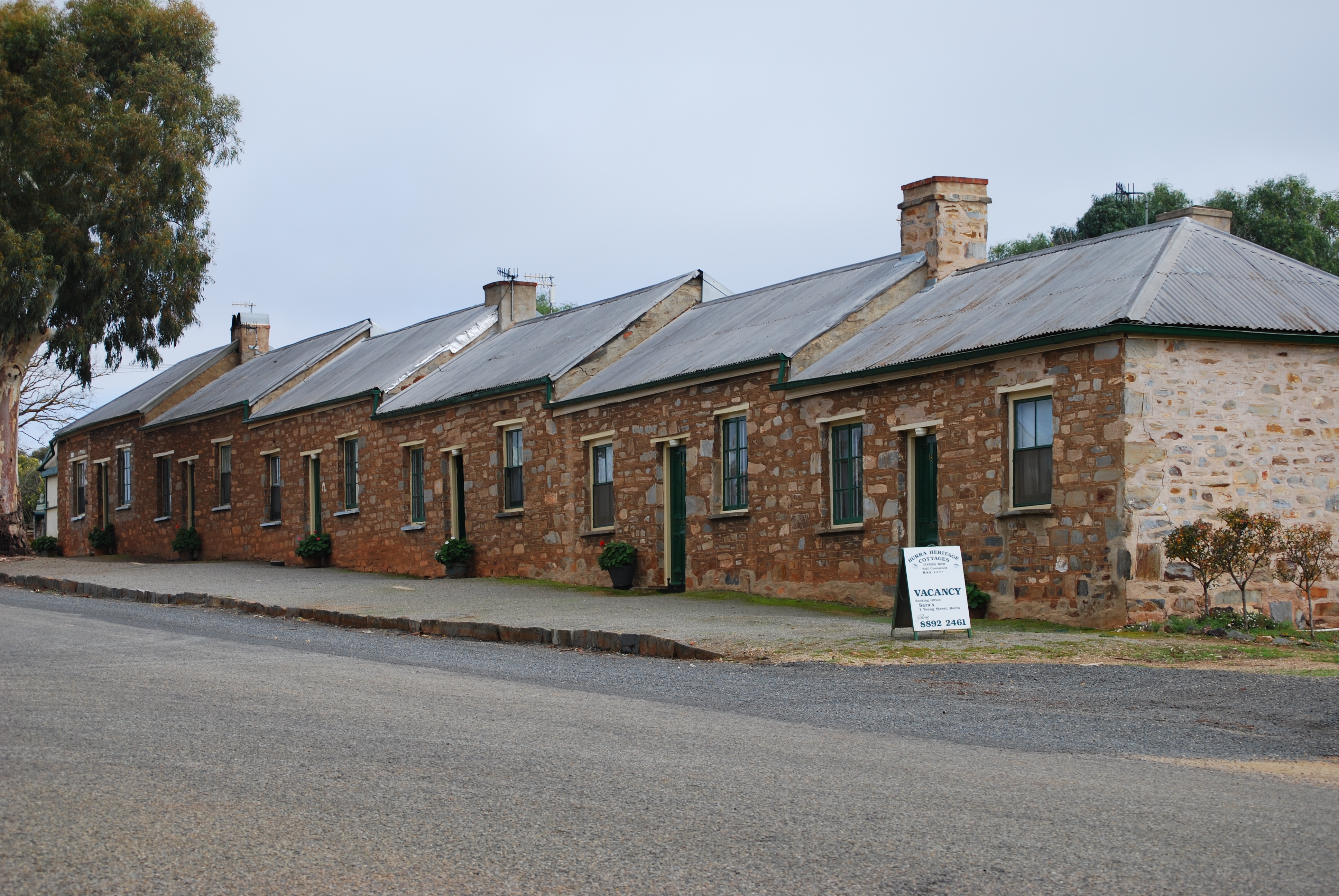 |
| Tyvers cottages, Burra, SA |
 |
| Sadly decaying Burra Railway Station and tracks, Burma, SA |
 |
| Pearce’s building was built in 1914 by Burra builder John Pearce, SA |
 |
| Abandoned farmhouse near Burra. Pexels.com |
 |
| Redruth Gaol, Burra, South Australia. Used in the film "Breaker Morant" |
 |
| Dis-used copper mines, Burra, SA |
 |
| Commercial Hotel Burra, SA |
 |
| Explosives used for mining were stored in the Powder Magazine. Built in 1847, Burma, SA |
 |
| Burra, SA. Kooringa Hotel was established in 1884, providing four rooms of accommodation with shared facilities |
.jpg) |
| Burra Burra Copper Mine, South Australia |
 |
| Heritage building, Burra, SA |
 |
| The Burra Hotel originally built 1847 |
Burra Jinker
This 10-metre long Burra jinker was used to carry engines and boilers for the Burra Mine in the 1850s, using 40 oxen to draw it. The South Australian Heritage Council entered the Burra jinker in the SA Heritage Register in 2016. It's on display at Burra.
 |
| Wooden and iron mine cart was first used in 1850 to carry a boiler for the Burra mine's Morphett engine house from Port Adelaide |
 |
| Historic Bon Accord Hotel, Burma, SA, circa 1875 |
 |
| Former Primitive Methodist Church and Masonic Lodge c 1850 Burra, South Australia |
 |
| The St Mary the Virgin Anglican Church, Burra. SA. The first St Mary's was built in 1848 with the current one dating from 1879 |
 |
| St Paul's Anglican Church, built in 1868, Burra, SA |
 |
| Redruth Gaol, circa 1856 (used in the film Breaker Morant), Burma, SA |
 |
| Burra Market Square Museum was originally the residence and shop of Andrew Wade a tailor, built in 1880 |
Things To Do and Places To Go
Interactive Map of Burra
Books to Read
The Gommock, Exploits of a Cornish Fool in Colonial Australia, is a historical novel by
Marie S. Jackman based around the lives of a Cornish
emigrant miner, Yestin Tregarthy, and his wife Charlotte, set at the Burra Burra copper mine in South Australia







































.jpg)




